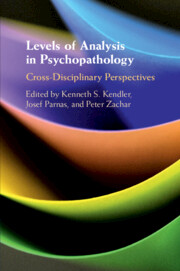Book contents
- Levels of Analysis in Psychopathology
- Advance Praise for Levels of Analysis in Psychopathology
- Levels of Analysis in Psychopathology
- Copyright page
- Contents
- Figures
- Tables
- Contributors
- Preface
- General Introduction
- Part I Neuroscience, Mechanisms, and RDoC
- Section 1
- Section 2
- 4 Introduction
- 5 Wrangling the Matrix: Lessons from the RDoC Working Memory Domain
- 6 Brain and Mind in Psychiatry? Presuppositions of Cognitive Ontology
- Section 3
- Part II Phenomenology, Biological Psychology, and the Mind–Body Problem
- Part III Taxonomy, Integration, and Multiple Levels of Explanation
- Index
- References
6 - Brain and Mind in Psychiatry? Presuppositions of Cognitive Ontology
from Section 2
Published online by Cambridge University Press: 02 April 2020
- Levels of Analysis in Psychopathology
- Advance Praise for Levels of Analysis in Psychopathology
- Levels of Analysis in Psychopathology
- Copyright page
- Contents
- Figures
- Tables
- Contributors
- Preface
- General Introduction
- Part I Neuroscience, Mechanisms, and RDoC
- Section 1
- Section 2
- 4 Introduction
- 5 Wrangling the Matrix: Lessons from the RDoC Working Memory Domain
- 6 Brain and Mind in Psychiatry? Presuppositions of Cognitive Ontology
- Section 3
- Part II Phenomenology, Biological Psychology, and the Mind–Body Problem
- Part III Taxonomy, Integration, and Multiple Levels of Explanation
- Index
- References
Summary
Psychiatric diagnosis and research is hampered by problems in nosological classification. Recent development has seen the suggestion of dimensionally-based classification systems like the Research Domain Criteria (RDoC) and cognitive ontology (CO), with the latter being developed by Bilder in his chapter. I here discuss some usually tacit or implicit presuppositions of CO concerning brain and mind. I conclude that, despite shifting from an entity-based approach (as in the DSM) to a dimensional approach, the cognitive ontology project still encounters the problem of connecting neuronal changes to psychopathological symptoms and, more generally, brain and mind.
Keywords
- Type
- Chapter
- Information
- Levels of Analysis in PsychopathologyCross-Disciplinary Perspectives, pp. 78 - 86Publisher: Cambridge University PressPrint publication year: 2020

